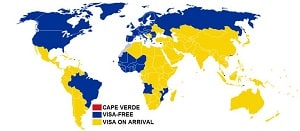Cape Verdean Culture

Cape Verdean culture is a rich tapestry woven from African, Portuguese, and Brazilian influences, reflecting the archipelago's history and geographical location. Here's a detailed exploration of the various aspects of Cape Verdean culture:
Cape Verde Music and Dance
Cape Verde Morna Description: A melancholic and soulful music genre, often compared to Portuguese fado.
Cape Verde Morna Notable Artist: Cesária Évora, known as the "Barefoot Diva," is the most famous performer of morna.
Cape Verde Morna Instruments: Typically includes guitar, cavaquinho (a small string instrument), violin, and clarinet.
Cape Verde Coladeira
Cape Verde Coladeira Description: An upbeat and rhythmic genre evolved from morna, addressing social issues, love, and everyday life.
Cape Verde Coladeira Instruments: Features guitar, accordion, and percussion instruments.
Cape Verde Funaná
Cape Verde Funaná Description: A lively and fast-paced dance music originating from Santiago Island, often associated with social and political expression.
Cape Verde Funaná Instruments: Dominated by the gaita (accordion) and ferrinho (metal scraper).
Cape Verde Batuque
Cape Verde Batuque Description: A traditional music and dance form characterized by polyrhythmic drumming and call-and-response singing, deeply rooted in African traditions.
Cape Verde Batuque Popular On: Santiago Island.
Cape Verde Festivals and Culture
Carnival in Mindelo (São Vicente)
Carnival in Mindelo (São Vicente) Description: The largest and most vibrant carnival in Cape Verde, featuring colorful parades, music, and dance.
Carnival in Mindelo (São Vicente) Timing: Usually takes place in February, aligning with the pre-Lenten season.
Gamboa Festival (Praia, Santiago)
Gamboa Festival (Praia, Santiago) Description: A major music festival attracting local and international artists.
Gamboa Festival (Praia, Santiago)Features: Performances across various music genres, including traditional Cape Verdean music and contemporary styles.
Cape Verde Tabanka Festival
Cape Verde Tabanka Festival Description: A traditional festival celebrating African heritage and honoring ancestors.
Cape Verde Tabanka FestivalFeatures: Processions, music, dance, and symbolic rituals.
Cape Verde Cuisine
Cachupa Description: The national dish, a slow-cooked stew made with corn (hominy), beans, sweet potatoes, cassava, and various meats or fish.
Cachupa Variations:
Cachupa Rica: Richer, with multiple types of meat.
CachupaCachupa Pobre: Simpler, with fewer ingredients.
Cape Verde Pastel com diablo dentro
Cape Verde Pastel com diablo dentro Description: Fried pastries filled with spicy tuna or meat.
Cape Verde Pastel com diablo dentro Name Meaning: "Pastry with the devil inside," referring to the spicy filling.
Cape Verde Grogue Description: Traditional Cape Verdean liquor made from sugarcane, similar to rum.
Cape Verde Grogue Use: Consumed neat or as a base for cocktails.
Cape Verde Art and Craft
Cape Verde Weaving and Embroidery Products: Traditional items include woven baskets, mats, and embroidered linens.
Cape Verde Weaving and Embroidery Styles: Reflect a blend of African and Portuguese influences.
Cape Verde Pottery and Ceramics
Cape Verde Features: Handcrafted using traditional techniques, often featuring local motifs and designs.
Painting and Sculpture Themes: Often depict everyday life, historical events, and Cape Verdean folklore.
Painting and Sculpture Materials: Commonly use wood, clay, and recycled materials.
Cape Verde Language and Literature
Languages Portuguese: The official language used in government, media, and education.
Cape Verdean Creole (Kriolu): The mother tongue of most Cape Verdeans, with variations across the islands.
Cape Verde Literature Genres: Includes poetry, prose, and oral storytelling.
Cape Verde Notable Authors: Eugénio Tavares (morna lyrics and poetry), Germano Almeida (novelist known for his satirical style).
Cape Verde Traditional Clothing
Cape Verde Women's Attire
Pano di terra: A traditional handwoven cloth used to make skirts, shawls, and head wraps.
Modern Use: Often worn during cultural festivals and special occasions.
Cape Verde Men's Attire
Cape Verde Traditional Dress: Includes tunics and loose-fitting trousers, often made from colorful fabrics.
Cape Verde Modern Use: Traditional clothing is less common in everyday life but is worn during cultural events.
Cape Verde Religion and Beliefs
Christianity Dominant Religion: The majority of Cape Verdeans are Roman Catholic.
Christianity Influence: Catholic traditions and holidays play a significant role in cultural life.
Syncretism Blending: Traditional African beliefs and practices are often blended with Christian rituals.
Examples: Certain festivals and ceremonies incorporate elements of both faiths.
Cape Verde Folklore and Traditions
Cape Verde Folklore and Traditions Storytelling Role: Oral storytelling is a vital part of preserving history and cultural identity.
Cape Verde Folklore and Traditions Common Themes: Folk tales often feature moral lessons, heroes, and supernatural elements.
Cape Verde Folklore and Traditions Proverbs and Sayings
Cape Verde Folklore and Traditions Usage: Widely used in daily conversation to convey wisdom and cultural values.
Cape Verdean culture is a vibrant and dynamic blend of influences, creating a unique and rich cultural heritage. The islands offer a captivating mix of music, dance, cuisine, art, and traditions that reflect the resilience and creativity of the Cape Verdean people.





 |
|  |
|  |
|  |
| 